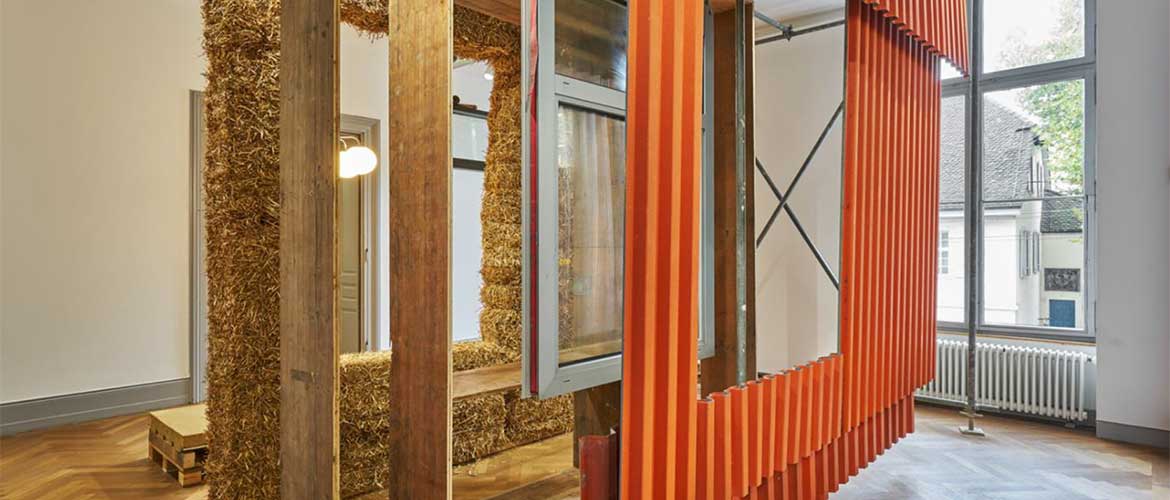
Exhibition at the HDA – Haus der Architektur, Graz.
Opening: 14 April 2021, Open House 11am–5pm.
Duration of exhibition: 15 April to 4 July 2021.
Accompanying event: Conference, 2 July 2021.
A publication will accompany the exhibition.
The increasing awareness of the finite nature of material and energy resources in the context of the challenges of climate change poses new questions and tasks for the construction industry. Studies show that this industry alone is responsible for 40 per cent of waste, 40 per cent of primary energy resource consumption and 40 per cent of carbon emissions worldwide. The rapid growth of cities in particular is contributing to this phenomenon. According to United Nations calculations, about 55 per cent of the world’s population live in cities today. By 2050, this figure will reach around 68 per cent – there will be around 6.34 billion city dwellers. This will present enormous challenges in terms of resource consumption in the building industry, as we construct new buildings and develop new infrastructure.
Currently, our economic system is primarily linear. Raw materials are extracted, used, and become part of our built environment. When no longer needed, they become waste, having reached the end of the consumption chain. However, scientists, researchers and experts have long been calling for a mind shift towards a “circular economy” in which raw materials are given a new usage when they no longer fulfil their original purpose. In cities in particular, there is a dense concentration of resources that can be incorporated into a cycle of value creation using urban mining or material harvesting, facilitating new business models and making a sustainable and climate-friendly economy possible. To actively implement this, a new legal framework is needed that encourages a circular economy and regulates important aspects such as warranty.
Incorporating building materials into material cycles used to be a widespread practice in construction. Until around 200 years ago, the most commonly used materials were stone, wood, lime, clay and plant fibres – most of them highly robust. These natural building materials were either reused or returned to the natural material cycle through processes of decay. Today’s building materials are complex, often consisting of multi-layered components and including different constituent materials and coatings, made, for example, of plastics, which are often difficult to reuse and after demolition frequently end up in a hazardous waste landfill.
Back in 2016, the United Nations adopted the Sustainable Development Goals, which call for countries to move towards a sustainable circular economy and sustainable urban development. On 16 September 2020, President of the European Commission Ursula von der Leyen therefore gave top priority to the circular economy with the aim of achieving the 2050 climate targets: “The circular economy, including new waste and recycling laws, will represent half of the EU’s effort to achieve net-zero carbon emissions by 2050”.
The exhibition at the HDA presents studies and practical examples of architectures, conversions and system cycles that impress with their high design quality as well as their genesis from reused material resources.
The exhibition shows buildings and projects by: _baubüro in situ/Switzerland:
K118/Winterthur, ELYS Lysbüchel Areal/Basel, Werkhof Binz/Zurich _de Architekten Cie./Amsterdam: Circl Pavilion/Amsterdam _Superuse Studios/Rotterdam: Villa Welpeloo/Enschede, Wikado Playground/Rotterdam _materialnomaden and ATP architekten ingenieure/Vienna: magdas Großküchen/Vienna _CITYFÖRSTER/Hanover: Lune Delta°/Bremerhaven, Recycling Haus/Hanover
_Bundesimmobiliengesellschaft/Vienna with BauKarussel/Vienna: MedUni Campus Mariannengasse/Vienna
_Architekturbüro forschen planen bauen – DI Thomas Romm, Wien and Österreichisches Siedlungswerk: Urban Mining, construction site Q5 (ÖSW), Reininghaus/Graz
_Institute for Architecture Technology/TU Graz: workshop “House Remixed”
The project and exhibition are curated by: HDA – Haus der Architektur
Cooperation with Kunsthaus Graz in the context of Steiermark Schau
The exhibition “what will be” at the Kunsthaus Graz focusses on identifying traces of the future in the here and now. Taking Styria as its starting point, it outlines conceivable and possible futures as well as concrete utopias within a fabric of artistic and scientific perspectives. This multifaceted exhibition focusses on a responsible approach to resources, the circular economy and the use of sustainable materials in construction, and beyond. studio itzo has constructed the exhibition architecture primarily out of elements that were either used in previous exhibitions or excavated together with materialnomaden and BauKarussell during demolition projects. Visitors will see work such as Andreas Fogarasi’s Material Library, which takes a look at the built environment of the near future. The Kunsthaus Graz and the HDA are taking this interdisciplinary theme as an opportunity to offer a joint programme of events:
Programme of events
Guided tours HDA/Kunsthaus Graz
There will be regular, inter-museum guided tours through both exhibitions, focussing on the circular economy and sustainable building materials.
Film evenings
The Kunsthaus Graz and the HDA are organising joint film screenings with a diverse programme around sustainability in construction as well as sustainable urban and spatial development.
Conference
A one-day conference is planned on 2 July 2021 which offers trailblazers and experts on the circular economy an opportunity to enter into an international dialogue with local politicians and building industry stakeholders.
Cooperation with CLB Berlin and Architekturgalerie München
The HDA, the CLB Berlin and the Architekturgalerie München have worked together to create a collaborative programme for the current year that aims to raise international public awareness of the circular economy. Each institution has developed an exhibition and an accompanying programme of events, collaborating with local universities on the topic.
More information on the programmes in Munich and Berlin will soon be available here:
CLB Berlin
https://www.clb-berlin.de/
Architekturgalerie München
https://www.architekturgalerie-muenchen.de/programm.html
For further information, please visit the HDA website
https://hda-graz.at/programm/material-loops-en.
Press images are available at
https://hda-graz.at/pressebereich-hda/pressemappe-material-loops.
Press info:
DI Yvonne Bormes | Communications Haus der Architektur | House of Architecture
www.hda-graz.at
